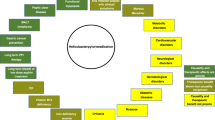Abstract
Helicobacter pylori remains a controversial organism with regards to humans, with its epidemiology still being unclear nearly two decades after its discovery. The association between H. pylori infection and subsequent development of chronic active gastritis, peptic ulcer disease, gastric cell carcinoma, and B cell mucosa-associated lymphoid tissue (MALT) lymphoma has been well established. Current studies, however, suggest that fewer than 20 % of all infected patients will develop any consequences from their infection. Hence, should the infection be considered a disease not at all or, on the contrary, is the microorganism harmful in only some circumstances? This article attempts to weigh the currently available evidence supporting that H. pylori may be good and not always bad.
Similar content being viewed by others
References
Cover TL, Blaser MJ (2009) Helicobacter pylori in health and disease. Gastroenterology 136:1863–1873
Hopkins RJ, Girardi LS, Turney EA (1996) Relationship between Helicobacter pylori eradication and reduced duodenal and gastric ulcer recurrence: a review. Gastroenterology 110:1244–1252
Gerhard M, Lehn N, Neumayer N et al (1999) Clinical relevance of the Helicobacter pylori gene for blood-group antigen-binding adhesin. Proc Natl Acad Sci U S A 96(22):12778–12783
van Doorn LJ, Figueiredo C, Sanna R et al (1998) Clinical relevance of the cagA, vacA, and iceA status of Helicobacter pylori. Gastroenterology 115(1):58–66
Covacci A, Telford JL, Del Giudice G, Parsonnet J, Rappuoli R (1999) Helicobacter pylori virulence and genetic geography. Science 284:1328–1333
Marshall BJ, Armstrong JA, McGechie DB, Glancy RJ (1985) Attempt to fulfil Koch’s postulates for pyloric Campylobacter. Med J Aust 142(8):436–439
Marshall BJ (1995) Helicobacter pylori in peptic ulcer: have Koch’s postulates been fulfilled? Ann Med 27(5):565–568
Blaser MJ (1999) Hypothesis: the changing relationships of Helicobacter pylori and humans: implications for health and disease. J Infect Dis 179:1523–1530
Song Q, Lange T, Spahr A, Adler G, Bode G (2000) Characteristic distribution pattern of Helicobacter pylori in dental plaque and saliva detected with nested PCR. J Med Microbiol 49:349–353
Monstein HJ, Tiveljung A, Kraft CH, Borch K, Jonasson J (2000) Profiling of bacterial flora in gastric biopsies from patients with Helicobacter pylori-associated gastritis and histologically normal control individuals by temperature gradient gel electrophoresis and 16S rDNA sequence analysis. J Med Microbiol 49:817–822
Boulos PB, Botha A, Hobsley M, Holton J, Oshowo AO, Tovey FI (2002) Possible absence of Helicobacter pylori in the early stages of duodenal ulceration. QJM 95:749–752
Dres Pest P, Zárate J, Varsky C, Man F, Schraier M (1996) Helicobacter pylori in recently-diagnosed versus chronic duodenal ulcer. Acta Gastroenterol Latinoam 26:273–276
Hobsley M, Tovey FI (2001) Helicobacter pylori: the primary cause of duodenal ulceration or a secondary infection. World J Gastroenterol 7(2):149–151
Nath G, Khanna AK, Jain AK, Gulati VK (2000) Helicobacter pylori does not cause gastric carcinoma in India. Nat Med J India 13(6):328–329
Ally R, Mitchell HM, Segal I (2000) Differences in the immune response to H. pylori infection in Sowetan subjects may relate to concurrent parasitic infections. S Afr Med J 90:642
Fox JG, Beck P, Dangler CA et al (2000) Concurrent enteric helminth infection modulates inflammation and gastric immune responses and reduces Helicobacter-induced gastric atrophy. Nat Med 6(5):536–542
Rastogi T, Devesa S, Mangtani P et al (2008) Cancer incidence rates among South Asians in four geographic regions: India, Singapore, UK and US. Int J Epidemiol 37(1):147–160
Schmidt HM, Goh KL, Fock KM et al (2009) Distinct cagA EPIYA motifs are associated with ethnic diversity in Malaysia and Singapore. Helicobacter 14(4):256–263
Mishra S, Singh V, Rao GR, Dixit VK, Gulati AK, Nath G (2008) Prevalence of Helicobacter pylori in asymptomatic subjects—a nested PCR based study. Infect Genet Evol 8:815–819
Elitsur Y, Neace C, Werthammer MC, Triest WE (1999) Prevalence of CagA, VacA antibodies in symptomatic and asymptomatic children with Helicobacter pylori infection. Helicobacter 4(2):100–105
Carroll IM, Khan AA, Ahmed N (2004) Revisiting the pestilence of Helicobacter pylori: insights into geographical genomics and pathogen evolution. Infect Genet Evol 4:81–90
Atherton JC, Blaser MJ (2009) Coadaptation of Helicobacter pylori and humans: ancient history, modern implications. J Clin Invest 119:2475–2487
Bach JF (2002) The effect of infections on susceptibility to autoimmune and allergic diseases. N Engl J Med 347:911–920
Richter JE, Falk GW, Vaezi MF (1999) Helicobacter pylori and gastroesophageal reflux disease: the bug may not be all bad. Am J Gastroenterol 93:1800–1802
Rothenbacher D, Blaser MJ, Bode G, Brenner H (2000) Inverse relationship between gastric colonization of Helicobacter pylori and diarrheal illnesses in children: results of a population-based cross-sectional study. J Infect Dis 182:1446–1449
Befrits R, Sjöstedt S, Ödman B, Sörngård H, Lindberg G (2000) Curing Helicobacter pylori infection in patients with duodenal ulcer does not provoke gastroesophageal reflux disease. Helicobacter 5(4):202–205
El-Omar EM, Oien K, El-Nujumi A et al (1997) Helicobacter pylori infection and chronic gastric acid hyposecretion. Gastroenterology 113(1):15–24
Chow WH, Blaser MJ, Blot WJ et al (1998) An Inverse relation between cagA+ strains of Helicobacter pylori infection and risk of esophageal and gastric cardia adenocarcinoma. Cancer Res 58:588–590
Williamson WA, Ellis FH Jr, Gibb SP et al (1991) Barrett’s esophagus. Prevalence and incidence of adenocarcinoma. Arch Intern Med 151:2212–2216
Iftikhar SY, James PD, Steele RJC, Hardcastle JD, Atkinson M (1992) Length of Barrett’s oesophagus: an important factor in the development of dysplasia and adenocarcinoma. Gut 33:1155–1158
van Sandick JW, van Lanschot JJB, Kuiken BW, Tytgat GNJ, Offerhaus GJA, Obertop H (1998) Impact of endoscopic biopsy surveillance of Barrett’s oesophagus on pathological stage and clinical outcome of Barrett’s carcinoma. Gut 43:216–222
Conflict of interest
The author declares that they have no conflict of interest. The author does not have any financial relationship with the organization that sponsored the research.
Author information
Authors and Affiliations
Corresponding author
Rights and permissions
About this article
Cite this article
Mishra, S. Is Helicobacter pylori good or bad?. Eur J Clin Microbiol Infect Dis 32, 301–304 (2013). https://doi.org/10.1007/s10096-012-1773-9
Received:
Accepted:
Published:
Issue Date:
DOI: https://doi.org/10.1007/s10096-012-1773-9




